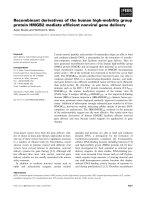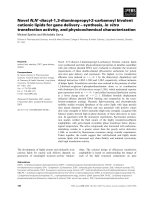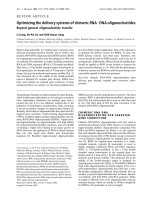Novel CNS gene delivery systems
Bạn đang xem bản rút gọn của tài liệu. Xem và tải ngay bản đầy đủ của tài liệu tại đây (2.71 MB, 146 trang )
NOVEL CNS GENE DELIVERY SYSTEMS
Li Ying
M. Sc. & B. Med.
A THESIS SUBMITTED FOR THE DEGREE OF DOCTOR OF
PHILOSOPHY
DEPARTMENT OF BIOCHEMISTRY &
INSTITUTE OF BIOENGINEERING AND NANOTECHNOLOGY
NATIONAL UNIVERSITY OF SINGAPORE
2004
I
Dedicated with love to my husband and my parents
II
ACKNOWLEDGMENT
My deepest appreciation to my supervisor Dr Shu Wang, Group leader, Institute of
Bioengineering and Nanotechnology, Associate Professor, Department of Biologic
Science, NUS, for his full support, untiring guidance, stimulating discussions, and
constant encouragement.
I also want to give my heartfelt gratitute to my co-supervisor Dr Hanry Yu, Associate
professor, Department of Physiology, and Dr Caroline Lee, Assistant professor,
Department of Biochemistry, for their constant review of my work and inspirting advice.
Without their help the thesis would not be done so smoothly.
Thanks to Professor KW Leong, The John Hopkins University, for his invaluable
guidance and support in the ‘PPE-EA’ project.
I would also like to express my appreciation to Dr Wang Xu, Dr Liu Beihui, Mr. Gao
Shujun, Ms. Ma YueXia and every body in our group for their technical advice,
invaluable discussions, and more importantly, their friendship.
I want to thank the National University of Singapore for the Research Scholorship, IMRE
and IBN for the state-of-art working enviroment and facilities.
To my parents and my husband, I thank you for your immeasurable understanding,
patience and support.
III
TABLE OF CONTENTS
TITLE I
DEDICATION II
ACKNOWLEDGMENT III
TABLE OF CONTENTS IV
SUMMARY VII
LIST OF FIGURES IX
LIST OF PUBLICATIONS XII
ABBREVIATION XIII
CHARPTER 1. GENERAL INTRODUCTION 1
1.1 Nonviral gene delivery in CNS 1
1.2 Viral gene delivery in CNS 3
1.3 Objectives of the research 5
CHAPTER 2. LITERATURE REVIEW 7
2.1 CNS gene delivery systems 7
2.2 Nonviral gene delivery systems 7
2.2.1 PEI mediated gene delivery 8
2.2.1.1 PEI chemistry 8
2.2.1.2 PEI as an efficient gene delivery vector 9
2.2.1.3 Toxicity of PEI 11
2.2.2 Gene delivery by Naked DNA 11
2.2.2.1 Naked DNA mediated transfection 11
2.2.2.2 Physical methods of naked DNA delivery 12
2.3 Viral gene delivery systems 14
2.3.1 Properties of the ideal viral vector 14
2.3.2 Characteristics of commonly used viral vectors 16
2.3.2.1 HSV-1 recombinant virus and amplicon vectors 16
2.3.2.2 Adeno-associated virus (AAV) vectors 17
2.3.2.3 Adenovirus (Ad) vectors 17
2.3.2.4 Retrovirus vectors 18
2.3.2.5 Lentivirus vectors 19
2.3.3 Recombiant baculovirus vector 20
2.3.3.1 The baculovirus family 20
2.3.3.2 Baculovirus infection cycle, replication and gene expression 21
2.3.3.3 Baculovirus-mediated gene transfer in mammalian cells 22
2.3.3.4 Baculovirus-mediated gene delivery in vivo 25
2.3.3.5 Advantages of Baculovirus as a gene delivery vector 26
2.3.3.5.1 Biosafety of baculovirus vectors 26
2.3.3.5.2 Large insert capacity 26
2.3.3.5.3 Broad cell type specificity 26
2.3.3.5.4 Simple manipulating and producing procedure 27
2.4 CNS circuits 27
2.4.1 Corticostriatal system 27
2.4.2 Nigrostriatal system 29
2.4.3 The visual system 32
IV
2.4.3.1 Retina 32
2.4.3.2 Optic nerve 33
2.4.3.3 Lateral geniculate nucleus (LGN) 34
2.4.3.4 Superior colliculus 34
2.4.3.5 Primary visual cortex 34
CHAPTER 3. DEGRADABLE POLYCATION PPE-EA AS A NOVEL DNA
CARRIER FOR CNS GENE TRANSFER: A COMPARISON WITH PEI 36
3.1 Abstract 36
3.2 Introduction 36
3.3 Materials and Methods 38
3.3.1 Materials 38
3.3.2 Plasmid 39
3.3.3 Preparation and characterization of DNA/polymer complexes 39
3.3.4 Atomic Force Microscopy (AFM) 40
3.3.5 Animals and injection procedures 41
3.3.6 Luciferase activity assay 42
3.3.7 Immune staining 43
3.3.8 Cytotoxicity Assay 43
3.3.9 Tissue biocompatibility 44
3.4 Results 45
3.4.1. Physical characteristics of PPE-EA/DNA complex 45
3.4.2 Gene transfection efficiency 49
3.4.3. Cytotoxicity and tissue responses 54
3.5 Discussion 58
CHARPTER 4. NEURON-TARGETED GENE TRANSFER BY BACULOVIRUS-
DERIVED VECTOR ACCOMMODATING A NEURON-SPECIFIC PROMOTER
63
4.1 Abstract 63
4.2 Introduction 64
4.3 Materials and methods 67
4.3.1 Production of recombinant virus vectors 67
4.3.2 Cy3 labeling of baculovirus 70
4.3.3 Cell line and primary cell cultures 70
4.3.4 Virus infections 72
4.3.5 Animals 73
4.3.6 Brain Injection Methods 73
4.4 Results 76
4.4.1 Visualization of baculovirus entry in vitro and in vivo 76
4.4.1.1 Baculovirus entry into differentiated PC12 cells 77
4.4.1.2 Baculovirus entry in primary neuron cells 78
4.4.1.3 Baculovirus entry in neural cells in vivo 81
4.4.2 Neuron-specific gene expression derived from BV-CMV E/PDGF in vitro
and in vivo 82
4.4.2.1 Neuron-specific gene expression in primary neural cells 82
4.4.2.2 Neuron-specific expression in brain after intrastriatum injection 84
V
4.4.3 Prolonged transgene expression derived from BV-CMV E/PDGF in vitro
and in vivo 86
4.4.3.1 Prolonged transgene expression in primary neural cell cultures 86
4.4.3.2 Dose-response study in rat brain after intrastriatum injection 88
4.4.3.2 Time course study in rat brain after intrastriatum injection 89
4.5 Discussion 90
CHAPTER 5 AXONAL TRANSPORT OF RECOMBINANT BACULOVIRUS
VECTOR 95
5.1 Abstract 95
5.2 Introduction 96
5.3 Materials and methods 97
5.3.1 Intravitreous body injection 97
5.3.2 PCR detection of virus genome in tissue samples 97
5.3.3 Visualization of double labeling with confocal scanning microscopy 98
5.3.4 Luciferase assay 98
5.4.1 Retrograde transport of virus particle after intra-striatum injection 99
5.4.2 Axonal and anterograde transport of virus particle after intra-vitreous body
injection 104
5.4.2.1 Transport of Cy3 labeled virus particle 104
5.4.2.2 Baculovirus genome detected by PCR analysis 106
5.4.2.3 Reporter gene expression tested by luciferase assay 107
5.4.2.4 Reporter gene expression localized by double staining 108
5.5. Discussion 109
CHAPTER 6 CONCLUSIONS AND RECOMMENDATIONS 115
REFERENCE LIST 118
VI
SUMMARY
Gene therapy for neurological disorders requires carriers for the therapeutic genes which
can safely and efficiently carry the genes into desired cell types. To date, a large number
of viral and non-viral gene transfer vectors are used in the CNS gene delivery, and
significant advancements have been achieved, which bring closer to reality the
efficacious amelioration, even cure of CNS diseases.
However, at the present stage, none of the vectors can satisfy all the requirements of an
ideal CNS gene delivery vector. The aim of this study was to exploit suitable gene carrier
which has the potential for CNS gene delivery and to improve their performances in
terms of efficiency, biosafety, and specificity. Both non-viral and viral vectors were
involved in this research.
For the non-viral vector part, a newly developed biodegradable polymer, PPE-EA, was
adopted in CSF gene delivery. The gene transfer efficiency, distribution, cytotoxicity and
tissue response of this polymer were studied to evaluate the bioavailability of it in CNS
gene therapy. The results established the potential of PPE-EA as a biocompatible gene
carrier to achieve sustained gene expression in CNS.
For the viral vector part, a new baculovirus vector, BV-CMV E/PDGF, was constructed
by utilizing a hybrid neuronal specific promoter, CMV E/PDGF, to drive the model gene
expression. This recombinant baculovirus vector offered neuronal specific gene
expression in primary neural cells and in rat brain. On the other hand, the transport
profile of this recombinant baculovirus was systemically studies in several CNS
pathways for the first time. Bidirectional axonal transport and transneuronal transport was
detected in different CNS circuits.
In summary, the first part of this study established a DNA controlled release system in
CSF, based on the new biodegradable polycation, PPE-EA. In the second part, a novel
baculovirus vector accommodating a hybrid neuronal specific promoter successfully
realized the neuron-targeted gene expression in the rat brain, while previously used
VII
baculoviruse vectors bearing viral promoter were tested to be very poor in neuronal
transfection. This modification would greatly widen the availability of the baculovirus as
a CNS gene delivery vector. Finally, the delineation of the axonal transport paradigm of
baculovirus contributed to our knowledge of its particular attributes in CNS, which is
very important in terms of manipulating the transgene expression to fulfill the specific
therapeutic requirement of a certain neurological disorder.
VIII
LIST OF FIGURES
Chapter 2.
Fig. 2-1. Structures of PEI precursors and end products
Fig. 2-2. Schematic representation of DNA uptake by mammalian cells
Fig. 2-3. Structures of PPE-EA precursors and end products
Fig. 2-4. EM picture of Baculovirus
Fig. 2-5. Life cycle of Baculovirus
Fig. 2-6. Schematic diagram of baculovirus-mediated gene delivery
Fig. 2-7. Anatomical organization of the inputs to the basal ganglia
Fig. 2-8. Schematic diagram of major afferent and efferent projections from the
striatum
Fig. 2-9. Schematic picture of visual system
Chapter 3.
Fig. 3-1. Method of Intracisternal Injection
Fig. 3-2. Agarose gel electrophoresis of polymer/DNA complexes.
Fig. 3-3. AFM images.
Fig. 3-4. Luciferase expression in mouse brain after intracisternal injections.
Fig. 3-5. Time course for Naked DNA and PPE-EA/DNA complexes (N/P=0.5, 2.0)
after intracisternal injection.
Fig. 3-6. Comparison of the distribution of reporter gene expression with various
gene delivery systems.
Fig. 3-7. Confocal images of luciferase expression in the brain.
Fig. 3-8. Viability assay in C17.2 ( A: undifferentiated, B: differentiated), PC12 (C),
and NT2 (D) cells.
Fig. 3-9. Tissue response at day 7 after intracisternal injection of PPE-EA, PEI and
their DNA complexes.
Chapter 4.
Fig. 4-1. Schematic pictures of expression cassettes with different promoters
Fig. 4-3. Procedure of recombinant baculovirus particle generation
IX
Fig. 4-2. X Map of plasmid pFastBac
TM
Fig. 4-4. Measurement of viral titer by plaque assay.
Fig. 4-5. Schematic picture of intrastriatum injection method
Fig. 4-6. Confocal images of Cy3 labeled baculovirus internalized by
differentiated PC12 cells.
Fig. 4-7. Confocal images of Cy3 labeled baculovirus internalized by primary
neurons.
Fig. 4-8. Confocal images of Cy3 labeled virus taken up by neurons and glia cells
in the rat striatum.
Fig. 4-9. Confocal images of luciferase expression in mixed primary neural culture
with double-staining.
Fig. 4-10. Confocal images of luciferase expression in NeuN-positive cells in the rat
striatum.
Fig. 4-11. Activities of three different baculovirus vectors in primary neural cultures.
Fig. 4-12. Dose respondence of baculovirus infection after injection into rat striatum.
Fig. 4-13. Time course of luciferase expression after baculovirus injection into rat
striatum.
Chapter 5.
Fig. 5-1. Confocal images of uptake and transport of Cy3 labeled baculovirus in
striatal pathway.
Fig. 5-2. Baculovirus genome detected by PCR in rat brain after intra-striatum
injection.
Fig. 5-3. Luciferase expression in different brain area after intrastriatum injection.
Fig. 5-4. Confocal images showing luciferase expression in neurons after
intrastriatum injection.
Fig. 5-5. Confocal images of uptake and transport of Cy3 labeled baculovirus by
neurons after intra-vitreous body injection.
Fig. 5-6 Baculovirus genome detected by PCR in visual system after intra-vitreous
body injection.
X
Fig. 5-7 Luciferase expression along visual pathway after intra-vitreous body
injection.
Fig. 5-8 Confocal images showing luciferase expression in neurons after
intravitreous body injection.
XI
LIST OF PUBLICATIONS
1. Y Li, J Wang, C Lee, CY Wang, SJ Gao, GP Tong, YX Ma, H Yu, H-Q Mao, KW
Leong and S Wang, CNS Gene Transfer Mediated by A Novel Controlled Release
System Based on DNA Complexes of Degradable Polycation PPE-EA: A
Comparison with Polyethylenimine/DNA Complexes. Gene Therapy (2004), Vol.11,
109–114.
2. Li Y, Wang X, Guo H, Wang S. Axonal transport of recombinant baculovirus
vectors. Mol Ther. 2004 Dec;10(6):1121-9.
3. Li Y, Yang Y, Wang S. Neuronal gene transfer by baculovirus-derived vectors
accommodating a neurone-specific promoter. Exp Physiol. 2005 Jan;90(1):39-44.
4. L Shi, GP Tang, SJ Gao, YX Ma, BH Liu, Y Li, JM Zeng, YK Ng, KW Leong and S
Wang, Repeated Intrathecal Administration of Plasmid DNA Complexed with
Polyethylene Glycol-Grafted Polyethylenimine Led to Prolonged Transgene
Expression in the Spinal Cord. Gene Therapy (2003), Vol. 10(14), 1179-1188.
5. Tang GP, Zeng JM, Gao SJ, Ma YX, Shi L, Y Li, Too H-Pb and Wang S,
polyethylene Glycol modified Polyethylenimine for Improved CNS Gene Transfer:
Effects of PEGylation Extent, Biomaterials (2003), Vol. 24(13), 2351-2362.
Patent in Process:
PCT/SG2004/000089, Method of Using Baculovirus Vectors for Gene Delivery to
Neurons
XII
ABBREVIATION
AAV Adeno-associated virus
AcMNPV Baculovirus Autographa californica multiple nuclear polyhedrosis virus
BV Budded virus
β-Gal β-galactosidase
CNS Central Nervous System
CPs Cationic polymers
DAF Decay accelerating factor
GCL Ganglion cell layer
GFAP Glial fabrillary acidic proteins
HSV Herpes simplex virus
INL Inner nuclear layer
ITRs Inverted terminal repeats
LGB lateral geniculate nucleus
MNPV Multicapsid nucleopolyhedroviruses
MOI Multiplicity of infection
NeuN Neuron-specific nuclear protein
NPVs Nucleopolyhedroviruses
OBs Occlusion bodies
ODVs Occlusion derived virus
ON Optic nerve
PEI Poly(ethylenimine)
PLL Poly(L-lysine)
PPE-EA Poly(2-aminoethyl propylene phosphate)
CMV Cytomegalovirus promoter
PDGF Platelet derived growth factor
PVC Primary visual cortex
RLU Relative luciferase unit
SC Superior colliculus
SN Substantia nigra
SNPV Single capsid nucleopolyhedroviruses
XIII
TH Tyrosine hydroxylase
XIV
CHARPTER 1. GENERAL INTRODUCTION
A large number of CNS diseases, such as neurodegenerative diseases, some of the brain
tumors and traumatic brain are considered to be incurable to date. Gene transfer into the
central nervous system (CNS) offers the prospect of manipulating gene expression for
studying neuronal function and eventually for treating these incurable neurological
disorders. There are two different approaches currently being utilized for the delivery of
genetic materials in gene therapy: viral and non-viral gene delivery systems. Due to the
unique attributes of the CNS, there are some obstacles to overcome in achieving efficient
CNS gene delivery. One of the major obstacles is that CNS is more vulnerable and
sensitive to the treatment imposed on it, which underscores the importance of developing
safe gene delivery vectors and therapeutic administration methods. Another obstacle is
the great diversity of cell types in the CNS, many of which has critical physiological
functions and is highly sensitive to changes. This particular feature emphasizes the
necessity of targeted gene delivery to a specific cell type. Great successes have been
made in developing and exploring new gene delivery vectors in both nonviral and viral
systems, but each has their own limitations. In the following parts, the latest progresses in
both nonviral and viral vectors will be reviewed and their existing problems will be
discussed.
1.1 Nonviral gene delivery in CNS
The success of gene therapy is largely dependent on the development of the gene delivery
vector. Nonviral gene delivery vectors can be broadly categorized into three groups:
naked DNA, cationic polymer, and lipid. This thesis mainly focuses on cationic polymers
1
(CPs) capable of condensing large gene fragments into small structures and masking
negative DNA charges, which is necessary for transfecting most cell types. CPs-based
gene delivery systems have been viewed as an alternative to viral gene vectors for their
relatively low toxic effects and a lack of immune reactivity. Other potential advantages of
polymer gene delivery systems include their capability in accommodating large DNA
plasmids, simplicity in preparation, flexibility in use and cell-type specificity after
chemical conjugation of a targeting ligand (Niidome and Huang, 2002). Due to these
advantages, a number of cationic polymers have been studied and reported to be capable
of mediating gene transfection, such as poly(ethylenimine) (PEI) (Boussif et al.,
1995;Lambert et al., 1996), Poly(L-lysine) (PLL) (Wolfert et al. 1999), Chitosans
(Koping-Hoggard et al. 2001), Dendrimers (Tang et al. 1996), etc. Among these
commonly used polycations, PEI is considered to be the gold standard of non-viral gene
delivery due to its high transfection efficiency both in vivo and in vitro. In particular, PEI
polymers, especially those with molecular weight of 25 kD, may mediate DNA
transfection in terminally differentiated post-mitotic neurons (Abdallah et al. 1996;Goula
et al. 1998;Lambert et al., 1996;Shi et al. 2003;Wang et al. 2001), which is very
beneficial for gene delivery to neurons into the CNS. Abdallah et al. reported that after
direct brain injection, PEI/DNA complexes can provide transgene expression levels
comparable to those obtained with the HIV-derived vector or adenoviral vectors
(Abdallah et al., 1996). However, PEI has displayed toxicity and low biocompatibility to
various types of cells, including neurons and other cells in the nervous system (Lambert
et al., 1996;Shi et al., 2003). On the other hand, biodegradable polymers are known for
their low toxicity, high biocompatibility. However low transfection efficiency is their
2
common apparent shortcoming. Recently, a newly developed biodegradable polymer,
poly(2-aminoethyl propylene phosphate) [PPE-EA], shows very potent transfection
efficiency, low cytotoxicity and high biocompatibility in skeletal muscle gene delivery
(Wang et al., 2001;Wang et al., 2002), comparable to PEI and PLL. Although the
characteristics of PPE-EA listed above indicate that it may be suitable for CNS gene
delivery, the bioavailability of PPE-EA in CNS has not been studied.
1.2 Viral gene delivery in CNS
While non-viral vectors are considered to be promising alternative to viral vectors, viral
gene delivery systems nevertheless still occupy a dominant position in the gene therapy
field, owning to its high transfection efficiency unreachable by non-viral systems both in
vivo and in vitro. There are a lot of virus vector being utilized in CNS gene delivery,
including adenovirus, herpes simplex virus (HSV), adeno-associated virus (AAV),
lentivirus, etc. But all of these vectors have inherent drawbacks which greatly limit their
availability. Although a lot of efforts have been made in improving the performance of
these virus vectors, none of them can fulfill every requirement of an ideal CNS gene
delivery vector. Adenovirus and HSV vectors are highly immunogenic, and all
individuals have pre-existing immunity to both these viruses. A single intracerebral
injection of either adenovirus or HSV results in dose-dependent inflammatory reactions
in the brain leading to demyelination (Lawrence et al., 1999; McMenamin et al., 1998).
For lentivirus, the restricted host range, low titers, and pathogenic characteristics are all
amongst its limitations as a CNS gene delivery system. AAV vectors are characterized by
the inability to consistently induce immune responses, however its feasibility is restricted
3
by the small transgene holding capacity (Jooss and Chirmule 2003).
In recent years, promising viral vectors, based on insect baculovirus seems promising in
overcoming those barriers which existed in the viral systems mentioned above. The
baculovirus Autographa californica multiple nuclear polyhedrosis virus (AcMNPV) is a
newly emerged viral vector utilized in mammalian gene delivery system. It transfects a
wide range of cell lines derived from different species efficiently, and also mediates
significant transgene expression in different organs such as liver, spleen, kidney, brain,
etc, in some animal models (Ghosh et al., 2002; Huser and Hofmann 2003). Besides this,
baculovirus has other advantages such as replication deficiency in mammalian cell, large
insert holding capacity, and simple production procedure, etc. Sarkis (Sarkis et al., 2000)
described the transgene expression in several neural cell types after intra-striatum
injection. Lehtolainen (Lehtolainen et al., 2002) reported that baculovirus can efficiently
transfect the cuboid epithelium of the choroid plexus in ventricles after injection into
corpus callosum. To fully explore the potential of baculovirus vectors for CNS gene
delivery, it is necessary to carry out more studies to both widen and deepen our
knowledge in the attributes of this vector.
Although baculovirus can mediate CNS gene delivery, it shows very poor neuro-tropism
in the Sarkis (2000) and Lehtolainen’s study(2002). Since neurons are the major target
of gene therapy for many kinds of neurological disorders, this drawback will inevitably
limits the availability of baculovirus during CNS gene delivery. Hence, the problem of
how to achieve neuronal specific gene expression for the baculovirus vector will
4
extensively limit the utility of this vector. On the other hand, we are not clear about the
transport paradigm of the baculovirus in the nervous system, which is an important factor
to consider in its further application as a CNS gene delivery vector.
1.3 Objectives of the research
The purpose of this study was to exploit novel non-viral and viral gene delivery vectors
that can satisfy the requirements of an ideal CNS gene delivery vector, that is, with low
cytotoxicity and high biocompatibility, high transfection efficiency, as well as specific
transgene expression. Although it may be difficult to achieve all the attributes in one
vector, it is possible to improve the performance of a vector by improving on the apparent
drawbacks and retaining the advantages at the same time.
The aim of the first part of the research was to evaluate the bioavailability of PPE-EA in
CNS gene delivery by intra-cisternal injection into cerebro-spinal fluid. PEI was used for
comparison in gene expression efficiency, distribution, and biocompatibility studies in
CNS. This detailed and systematic study may determine whether PPE-EA can be utilized
as a safe and efficient gene delivery carrier in CNS in the future.
In the second part, the purpose was to develop a baculovirus vector with neuronal
specific transfection. We constructed a recombinant baculovirus vector, namely, BV-
CMV E/PDGF, with neuronal specificity by using a hybrid neuronal specific promoter,
CMV E/PDGF, to control dreporter gene expression. To test the neuronal specificity of
this recombinant baculovirus, both in vitro and in vivo studies were adopted with BV-
5
CMV (CMV full length promoter was used) as a control. For the in vitro test, mixed
primary neural cells were used to measure virus gene delivery, and cell tropism was
compared between BV-CMV E/PDGF and BV-CMV. For the in vivo test, both BV-
CMV E/PDGF and BV-CMV was injected directly into the striatum. The in vivo cell
tropism and the duration of the transgene expression were studied. The efforts for
increasing the neuronal tropism of baculovirus may widen its availability as an efficient
CNS gene delivery vector.
The third part focused on investigating the transport aspects of baculovirus in the CNS
striatal pathway and visual pathway. Virus particles were injected into striatum and
vitreous body separately and the transportation was tested in different brain areas which
have connection with the injection site, at the DNA level by PCR and the protein level by
luciferase activity assay. The clarification of the transport paradigm of baculovirus in
CNS tissue may aid the design of targeting gene delivery to those brain regions that are
not reachable by a traditional strategy of direct administration.
6
CHAPTER 2. LITERATURE REVIEW
2.1 CNS gene delivery systems
The development of a gene delivery system is one of the most important technological
challenges for the goal of effective clinical therapy for CNS protection and repair. Many
improvements in safety, efficacy, stability and regulatability of gene transfer to the brain
are needed before realizing the purpose of clinical therapy. Advances in the modification
of vectors for gene delivery offered selective and specific delivery modalities. But, given
the complexity of the brain structure and diversity of CNS disorders, more efforts should
be made to develop and explore new vectors. CNS has some unique attributes, including
the post-mitotic nature of neurons, heterogeneity of cell types, critical functions of
specific neuronal circuits, limited access, volumetric constraints, and presence of the
blood-brain barrier, which are all challenges not usually at issue in gene therapy for other
organs. (Costantini et al., 2000) Thus, the genes and tools for gene delivery should be
tailored to meet the special therapeutic goals.
In this chapter, the nonviral and viral vectors commonly used in CNS gene delivery will
be reviewed.
2.2 Nonviral gene delivery systems
Nonviral gene delivery systems can be categorized into three groups: 1) naked DNA
delivery facilitated by physical methods, such as gene gun, electroporation, and
ultrasound, etc; 2) gene transfer mediated by cationic polymers, such as PEI, PLL,
chitosan, etc; 3) gene transfer mediated by lipids, such as N-[1-(2, 3-dioleoyloxy)propyl]-
N’,N’,N’-trimethyl-ammonium chloride (DOTAP). In the brain, nonviral vectors induce
7
nearly no immune response or toxic effects. However, there is a low efficiency of
expression of introduced genes compared with viral vectors (Brooks et al., 1998).
The following sections describe general profiles of PEI, naked DNA and PPE-EA, in
terms of their use as gene delivery vector.
2.2.1 PEI mediated gene delivery
2.2.1.1 PEI chemistry
Among nonviral gene carriers in use, the polycationic polymer, polyethylenimine (PEI),
has shown high transfection efficiency both in vitro and in vivo (Abdallah et al.,
1996;Boussif et al., 1995;Goula et al., 1998). PEI comes in two forms: linear and
branched. The branched form is produced by cationic polymerization from aziridine
monomers (Fig. 2-1) via a chain-growth mechanism, with branch sites arising from
specific interactions between two growing polymer molecules. The linear form of PEI
also arises from cationic polymerization, but from a 2-substituted 2-oxazoline monomer
(Fig. 2-1)instead. The product (for example linear poly(N-formalethylenimine)) is then
hydrolyzed to yield linear PEI(Godbey et al. 1999). PEI has repeated basic unites with a
backbone of two carbons followed by one nitrogen atom and contains primary, secondary,
and, in the case of branched PEI, tertiary amino groups, each of which can be potentialy
protonated.
8
Fig. 2-1. Structures of PEI precursors and end products *Aziridine can also yield
linear PEI under certain conditions. (adapted from Godbey, 1999)
2.2.1.2 PEI as an efficient gene delivery vector
The branched form of PEI has yielded significantly greater success in terms of cell
transfection, and is therefore the standard form of PEI that is used for gene delivery.
Highly branched polymers such as the 25-kDa PEI (Aldrich) and the 800-kDa PEI (Fluka)
as well as polymers with lower degrees of branching (Fischer et al., 1999) are most
frequently used. PEI mediates transfection by condensing DNA into
nanoparticles/complexes, protecting DNA from enzymatic degradation, and facilitating
the cell uptake and endolysosomal escape (Fig.2-2). PEI polymers are able to effectively
complex even large DNA molecules (Campeau et al., 2001), leading to homogeneous
spherical particles with a size of 100nm or less that are capable of transfecting cells
efficiently in vitro as well as in vivo.
9
Fig. 2-2. Schematic representation of DNA uptake by mammalian cells. DNA is
compacted in the presence of polycations into ordered structures such as toroids,
rods, and spheroids. These particles interact with the anionic proteoglycans at the
cell surface and are transported by endocytosis. The cationic agents accumulate in
the acidic vesicles, increase the pH of the endosomes, and inhibit the degradation of
DNA by lysosomal enzymes. They also sustain a proton influx, which destabilizes
the endosome, and release DNA. The DNA then is translocated to the nucleus either
through the nuclear pore or with the aid of nuclear localization signals, and
decondenses after separation from the cationic delivery vehicle. (adapted from
Vijayanathan, 2002)
PEI has been used as an efficient CNS gene delivery vector by several groups. The Feltz
group successfully transfected primary central and peripheral neurons with antisense
oligoneucleotides complexed by PEI (Lambert et al., 1996). High transfection efficiency
was detected in mature mouse brain by using PEI/DNA complex with PEI molecular
weight at 25-, 50- and 800- KD (Abdallah et al., 1996). But PEI 25- KD was tested to be
the most efficient one, compared with other two. Following these reports, many works
have been done using PEI for CNS gene delivery with PEI of different molecular weight,
10
by different injection pathway, or with different modifications (Goula et al., 1998;Shi et
al., 2003;Tang et al., 2003).
2.2.1.3 Toxicity of PEI
The ratio of PEI nitrogens to DNA phosphates is important in terms of transfection
efficiency and cell toxicity. Polymer/DNA complexes with an overall positive charge can
activate complement, and reducing the +/– charge ratio of the complexes reduces
complement activation as well as the amount of cell death associated with transfection
(Plank et al., 1996). The huge amount of positive charges of PEI polymers results in a
rather high toxicity, which is one of the major limiting factors especially for its use in
CNS gene therapy (Shi et al., 2003).
2.2.2 Gene delivery by Naked DNA
2.2.2.1 Naked DNA mediated transfection
Significant amount of data indicates that the uptake and expression of naked DNA is a
general property of animal cells within a tissue architecture. This phenomenon is
common to cells of all three lineages: endoderm (eg, hepatocytes), mesoderm (eg,
muscle), and ectoderm (eg, skin). Gene transfer to rodent brain by naked DNA has also
been reported (Schwartz et al., 1996). In the brain, as in peripheral tissues, naked DNA
vectors induce nearly no immune response or toxic effects. However, there is a low
efficiency of expression of introduced genes compared with viral vectors (Schwartz et al.,
1996). This property of transfection of neural cells is typically lost when the cells are
removed and maintained in culture.
11









